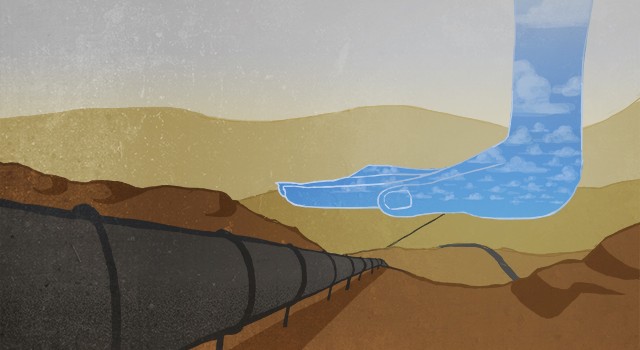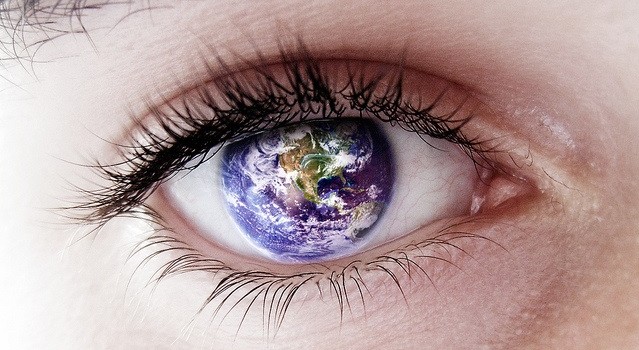Is the hydrocarbon economy too big to fail?
If the woefully inadequate outcome of the Paris climate conference is any indication, the answer is still a resounding “Yes!” That’s because the overly optimistic agreement conspicuously ignored the core issue driving up the earth’s temperature and warping the world’s already misshaped markets.
The problem is Big Oil.
Simply put, Big Oil is a bad investment fueled by irrational exuberance, chronic cronyism and an increasingly indefensible misallocation of capital. And decades of throwing good money after bad has produced a distorted economic system that socializes risk, privatizes profits, externalizes costs and misallocates capital. This continues because policy makers sustain it with taxpayer-funded subsidies, costly tax breaks and low-overhead access to publicly held resources.
By failing to institute much-needed cost internalization mechanisms and by completely avoiding the key problem of government subsidization, the cork-popping cadre of COP21 tacitly admitted what most cynics already knew – policy makers still believe “Big Oil” is far too big to fail. But, like other distorted markets in history, the correction is coming. The growing impact of climate change is exposing the key fallacy at the heart of the hydrocarbon economy: Big Oil cannot simply exempt itself from the natural economy governing all things in this closed system called planet Earth.
It’s Only Natural
Since Adam Smith published The Wealth of Nations in 1776, few ideas have captured the capitalist imagination like the notion that “an invisible hand” directs enterprising, self-interested individuals to produce a widely distributed wealth of social goods in spite of their self-serving intentions.
When the “self-serving” butcher, brewer or baker sells quality products at a fair price, they each profit from the returning patronage of their customers. Their customers enjoy good meat, fine ale and fresh bread. An invisible hand rewards these enlightened purveyors with enough money to eat well and drink well, too. And in the process, the whole village eats and drinks and thrives. But unenlightened sellers – those who peddle unnatural combinations of poor products at high prices – are driven out of business by the unsustainable inefficiencies produced by bad decisions and ill intentions.
This market correction happens, in no small part, because they’ve thrown the whole town – which is itself a mini financial ecosystem – completely out of balance with their bad meat and the lost wages from food-borne illnesses. Even worse is the disruption to the ethical butcher who gets undercut by malicious pricing from unscrupulous sellers. But, according to the theory, an invisible hand restores order to the town’s financial ecosystem when consumers react and economic balance is restored.
Over time, free-market devotees transformed Smith’s original theory of “an invisible hand” into “the invisible hand.” They believe “the hand” is a universal, natural force governing markets, meting out economic justice and controlling the fate of humankind. And they may be right. But they may also be surprised to find that “the hand” is connected to the right arm of Mother Nature and she’s using it to punish one of history’s most inefficient and least “enlightened” business models. By turning up the thermostat, filling the seas, altering climactic patterns and disrupting food chains, nature’s increasingly visible hand is “correcting” the shortsighted, heavily subsidized use of hydrocarbons to power an unsustainable, ecosystem-denuding industrial system.
Back in 1776, Adam Smith bemoaned the problem of unenlightened short-term thinking in investment and the distortions caused by corporate influence in politics. Like the seller of bad meat at an artificially low price, Big Oil has profited mightily from a short-term emphasis on high returns while its disproportionate political influence ensured the global village subsidized everything it’s been selling.
But Mother Nature is not a day trader.
It’s taken a while for all those bad debts and poor investments to fill up the ecological balance sheet with red ink. It started with the systematic extraction and use of coal during the Industrial Revolution. But there was a second “acceleration” when the oil and gas industry quite literally took off after World War II. That hydrocarbon liftoff was charted by the International Geosphere-Biosphere Programme (IGBP) on its planetary dashboard.
Since 1950, just about everything is through the roof. This “Great Acceleration” of both human activity and environmental degradation was fueled by the use and abuse of hydrocarbons – particularly the epic rise of the oil, gas and petrochemical industries in the post-World War II period.
The Hydrocarbon Economy
“Big Oil” is not just the drilling, shipping and refining of black gold into gasoline; it’s a complex matrix of transportation infrastructures, global military deployments, crucial currency pegs and malleable energy markets. Big Oil needs shipping lanes secured and pipelines financed. Their massive corporate investments must be protected from geopolitical threats. That protection comes from pliable politicians running well-funded governments with strong militaries. And resource-rich nations have to be succored and assuaged by taxpayer-supported geopolitical maneuvers, while demand for Big Oil’s consumer products are simultaneously sustained by well-greased policy makers back home.
And the “oil” economy is not just the “Brent light sweet crude” that sets the benchmark price of oil. The larger category of “hydrocarbons” includes petroleum, tar sands, shale oil, coal and so-called “natural” gas. All of these foundational energy sources propel the hydrocarbon economy.
But wait, there’s much, much more.
Oil and natural gas also feed the $3-trillion-plus global petrochemicals industry. Those petrochemicals are ubiquitous in consumer products and, as detailed in this staggering list, end up in “lubricants, additives, adhesives, sealants, agrochemicals, cosmetics, food flavorings and additives, fragrances, toothpaste, cleaning agents, inks, packaging and more.”
Ironically, petrochemicals stoked the post-World War II “Green Revolution” in agriculture – which combined petrochemical fertilizers with petrochemical pesticides, herbicides and fungicides to significantly increase crop yields. These innovations were coupled with fossil-fueled farm equipment to produce a massive spike in output that catalyzed humankind’s massive spike in population. That population spike is an important force multiplier driving the skyrocketing use of hydrocarbons over the last 50 years. And modern agriculture produces at least 25 percent of global carbon dioxide emissions.
Petrochemicals are also the main source of the world’s plastics. From the skin-scrubbing microbeads poisoning the world’s aquatic food chains to the megatons of discarded consumer goods clogging landfills, the $650 billion global plastic industry is the basis of the cheaply made, easily manufactured and highly globalized consumer product market called “the global economy.” Not coincidentally, demand for oil-generated plastic goods created in hydrocarbon-powered factories also stokes demand for the hydrocarbon-burning shipping infrastructure that moves those soon-to-be discarded products from polluted points of origin to product-hungry ports of call around the world.
Shockingly, a full one-quarter of the 334.83 million tons of plastic made annually ends up as packaging, and the market for shrink-wrapping, water bottles, disposable cups and all-too-common shopping bags is forecast to hit $370.25 billion by 2020. Yet, none of this begins to account for the staggering externalities of plastic – the health-care costs from toxic leeching, the despoiling of ecosystems, the poisoning of food chains and the loss of ecosystem services.
This is not just the polluted little secret of the plastics industry, but of the entire hydrocarbon economy. Its profitability is the result of a shortsighted, unenlightened reliance upon externalizing its true costs and upon a decidedly anti-free-market reliance on direct government interference in markets through a vast array of subsidies and market-rigging government handouts.
Externalities Über Alles
An externality is, according to Investopedia, a “consequence of an economic activity that is experienced by unrelated third parties.” And externalities can be either positive or negative. It’s easy to identify the positive externalities of the hydrocarbon economy. Oil has powered a higher standard of living for millions of people in the global North. Petrochemicals have generated such an agricultural bounty that the United States alone discards up to 40 percent of the food it produces annually without risking famine – yet. And cheap plastic manufacturing allows even many of the poorest members of rich economies unprecedented access to low-cost consumer goods.
On the other hand, the hydrocarbon economy has negatively externalized the impact of its business model by emitting greenhouse gases – carbon dioxide, methane, nitrous oxide and fluorinated gases – without ever paying for the actual cost of those emissions insofar as they impact the ecosystems upon which their businesses and, increasingly, the lives of their customers depend.
Another example of a negative externality is China’s massive share of global carbon dioxide emissions. According to the Global Carbon Project, China produces roughly 10 billion tons of carbon dioxide annually. That’s 29 percent of the world’s annual total and that’s more than the next two biggest emitters – the United States and European Union – combined. Critics cite China’s disproportionate role in global emissions as the main argument against US efforts to unilaterally curtail its emissions. But China’s responsibility for the carbon dioxide it releases is not as clear as it seems.
Although China’s emissions are twice the US total, a Harvard University study found that 25 percent of those “excessive” emissions actually result from exports to the United States and other economies. This is externalization on a geopolitical scale. The true costs of carbon dioxide and toxic pollution get externalized by the profit-hoarding power of politically vested corporate interests in the United States, which, in turn, still get to sell their polluting products to US customers.
In other words, externalization is an accounting trick.
This trick began when the Clinton administration catalyzed the offshoring of consumer manufacturing to China. China, in turn, became the world’s leading exporter of oil-reliant plastic widgets. It also became a coal-burning behemoth. Moreover, the cost of coal has been relentlessly externalized, so it’s a win-win for US corporations. And it also means China produces ever more carbon dioxide, and American enthusiasts of so-called “free trade” now use a cudgel to beat back “economically dangerous” domestic restrictions on carbon dioxide on the grounds of “competitiveness.”
That’s a win-win-win.
At the same time, this highly profitable, but highly polluting production in China is poisoning the air breathed by Chinese workers. Beijing is a swirling cauldron of particulate pollution and one estimate claims that 4,400 people die each day in China’s belching branch of the global hydrocarbon economy. That pollution is, in fact, an externalized outgrowth of hydrocarbon’s distorted market. Like bad meat and a low price, it is making the local village sick and skewing the market.
Sadly, capital is being misallocated into this deadly, market-distorting enterprise by unenlightened self-interest. But Mother Nature’s invisible hand is beginning to punish the Chinese branch of the economy through pollution-related health costs, lost wages and cascading negative effects on their environment – the land and water – which they desperately need to feed their people.
But Mother Nature is also fair.
She’s also punishing the United States with rising seas around Miami, the rising insurance costs due to “climate risk” and the growing cost of military preparations for the fallout from climate migrations and climate disruptions. These corrections are just the tip of the iceberg. Mother Nature’s increasingly visible handiwork is seen globally as petrochemicals poison increasingly scarce sources of arable land and potable water. She accounts for unenlightened palm oil agriculture by writing a major carbon sink off her books. She accounts for factory farming by disrupting oceanic food chains upon which humans depend. Some of those chains also lead back to carbon-capturing plankton. And all of these bitter returns on bad investments were born out of unsound market practices that couple externalization of the true costs with the market-corrupting influence of government subsidization.
Crony Carbonism
“There ain’t no such thing as a free lunch.”
The actual origin of the phrase is unclear, but sci-fi writer Robert Heinlein famously codified it in The Moon Is a Harsh Mistress (1966) and it quickly became shorthand for the idea that there is eventually a price to pay for everything – whether it’s in physics or economics or government.
Nobel-winning economist and free-market evangelist Milton Friedman wrote a book titled There’s No Such Thing as a Free Lunch in 1977 and he was particularly fond of using TANSTAAFL to argue against government spending.
The oddity, though, is that many of the taxpayer-funded lunches served up by Uncle Sam have been handed out to well-connected hydrocarbon capitalists. They reap the rewards of tax policies, trade agreements and government subsidies provided by the politicians they support in various governments. And the extent of those subsidies is woefully underestimated because many are “indirect” subsidies like a $305 billion highway bill or the $580 million “doubling” of the US Navy’s base in the oily emirate of Bahrain.
In the case of direct subsidies like direct government investment, tax breaks and public financing, a new report by the Overseas Development Institute (ODI) and Oil Change International (OCI) determined that the world’s “major” G-20 economies spend a combined $452 billion each year to subsidize the oil, gas and coal industries. The biggest spenders are China ($96.51 billion), Russia ($79.16 billion), Saudi Arabia ($51.895 billion), Brazil ($49.73 billion) and the United States ($20.491 billion).
Additionally, the International Energy Agency’s (IEA) World Energy Outlook 2015 report found the total amount spent globally on subsidies was approximately $490 billion in 2014. But both the ODI/OCI and IEA tabulations pale in comparison to the International Monetary Fund’s (IMF) assessment of global energy subsidies, which the IMF projected to reach $5.3 trillion in 2015. That’s a staggering 6.5 percent of global GDP being poured into subsidies.
Why the difference?
Because the IMF added in all of the costly market corrections that come with the use and abuse of hydrocarbons, including the high cost of global warming, chronic “undercharging” for domestic environmental damage, local air pollution, vehicle externalities “like traffic congestion and accidents,” and World Health Organization estimates of health costs related to pollution exposure.
And the picture of this grotesquely distorted market is made even clearer by the IMF’s estimate that simply eliminating energy subsidies could:
- reduce deaths related to fossil-fuel emissions by over 50 percent
- reduce fossil-fuel-related carbon emissions by over 20 percent
- deliver a $2.9 trillion revenue windfall from the positive externalities created by ending subsides
Whether it’s the IEA’s basic accounting or the IMF’s all-encompassing total, those publicly funded amounts dwarf the total investment allocated for renewable sources of energy. According to the United Nations Environment Program, global investment in renewable energy – including both public and private investment – surged 17 percent in 2014 to a paltry $270.2 billion.
Despite this overwhelming misallocation of public capital to hydrocarbons, the price per megawatt hour for renewables has dropped precipitously over the last decade. In fact, solar is not just competitive with hydrocarbons in an age of artificially low oil prices, but it is beginning to beat oil economically. And this is despite the US- and Saudi-led oil glut, which has destabilized markets and spread political turmoil around the world.
An enlightened, long-term investment strategy would exploit this cheap oil to radically ramp up production and installation of solar panels and wind turbines. Instead, the persistent instability of hydrocarbon-related “hot spots” sucks capital into indirect subsidies for hydrocarbon-powered military might. To wit, the United States spends as much on defense as the next seven biggest spenders combined. And Saudi Arabia is spending more than ever to protect its petrostate, in spite of its longstanding “special role” in the United States’ globe-spanning military protectorate.
Make no mistake, that protectorate follows the hydrocarbons.
The United States’ Pacific pivot is about competition for the oil-rich areas around disputed mini-islands in the South China Sea. And like they have done for decades in the Middle East, US policy makers are charged with the expensive task of preserving gatekeeper status over oil-heavy shipping lanes into Asia. They are also expected to exert geopolitical influence over oil-rich nations like Myanmar, Indonesia and Vietnam. The Trans-Pacific Partnership is part and parcel of that effort.
All of these geopolitical subsidies sit atop a pile of indirect domestic subsidies in the United States, including state- and federally funded infrastructure construction, publicly funded environmental remediation efforts, and stunningly low-cost leases to extract hydrocarbons from public lands. That is the hydrocarbon economy – a case study in bad economics, socialized risk and costly, government-fueled cronyism that not only misallocates capital, but also endangers the very infrastructure upon which it depends. It’s an economic bubble fueled by irrational decisions and bad, market-altering policies. Unlike the tech and housing bubbles, the hydrocarbon bubble has thus far avoided the massive, wholesale market correction that comes when the unsustainable force finally hits the immovable object of reality.
That is, until now.
The Market Correction Is Coming
In 2008, the great environmental thinker Lester Brown wrote about the inherent blindness of the invisible hand. Brown lamented the “fundamental weaknesses” preventing it from incorporating “the indirect costs of producing goods” into market prices and bemoaned the fact that it doesn’t “value nature’s services properly.” In the short term, Brown was right. But he underestimated the power of an even larger “economy” at work in the self-correcting system called “planet Earth.”
In less than a decade, Mother Nature’s ever more visible hand emerged as a force punishing the “market inefficiencies” and rampant externalization of the hydrocarbon economy. The best indicator of this correction is the mounting loss of “ecosystem services.” These are the common goods upon which human civilization – and, truth be told, all life – depends. Yet, humans simply take them for granted.
It’s the clean, clear water, life-sustaining oxygen and life-giving soil.
It’s the carbon-capturing forests and carbon-retaining power of the oceans.
It’s the 1/32 of the planet that is arable land.
Perhaps most pressing, it’s the crucial permafrost “carbon banks” found in the earth’s heretofore frozen regions. Permafrost matters because its long-frozen layers safely store greenhouse gases that slowly accumulated over the course of thousands of years. New research estimates a potential $43 trillion global economic impact should those “hundreds of billions” of tons of carbon dioxide and “billions of tons” of methane be released into the atmosphere by the rapidly warming Arctic. As Pacific Standard points out, that bill “isn’t a total cost to be spread out over several decades – it’s how much we’d have to set aside today to pay for the damage done by melting frozen soil, or permafrost, in the Arctic.” And yet more new research shows that Arctic regions are warming twice as fast as the world average because the solar-reflecting properties of the ice and snow are diminishing with each passing year.
That’s Mother Nature’s punishing handiwork.
Also diminishing each year are the unparalleled “ecosystem services” of the oceans, forests and other food webs that sustain earth’s interwoven fabric of life. Based on calculations by scientists at the United Nations University, the world forfeits a “staggering $6.3 trillion to $10.6 trillion” each year just from land degradation. That’s roughly “10-17% of global GDP.” What are the services lost? Properly cared for land provides “food, poverty reduction, clean water, climate and disease regulation and nutrients cycling.”
Hydrocarbon-obsessed humans have long ignored these opportunity costs, but Mother Nature factors it all into her bottom line. And we are running a massive budget deficit. That’s why tabulating “environmental services” is crucial to understanding the environmental deficit at the core of the hydrocarbon economy – and it’s crucial if human beings want to avoid the ultimate bankruptcy of extinction.
The most complete accounting thus far is the Earth Index compiled by BBC Earth. These stark juxtapositions represent just a small portion of wealth humans are squandering:
| Value of Earth Services | Value of Human Activities | |
| Freshwater = $73.48 trillion | compared to | The United States = $17.42 trillion |
| Trees = $16.2 trillion | compared to | Oil = $3.33 trillion |
| Coral Reefs = $9.9 trillion | compared to | US Coal = $36.67 billion |
| Bees and Pollinators = $170 billion | compared to | Starbucks = $16.45 billion |
| Dung Beetles = $380 million | compared to | The White House = $14.6 million |
| A Beaver = $120,000 | compared to | A US District Judge = $201,100 |
| Acre of Oyster Reef = $6,800 | compared to | Acre of US corn = $244 |
The value of coral reefs alone dwarfs the aggregate value of the world’s cinema ($36.4 billion) and the globe-spanning brand of Walt Disney ($48.81 billion), which also pales in basic economic comparison to both wild sea fish ($274 billion) and plankton ($222 billion). Plankton’s value is based in part on its role in capturing carbon. That is a service not provided by Disney.
But Mother Nature is tabulating the cost with each passing year as the impact of climate change compounds like bad interest. More greenhouse gases equal more warming, equals more carbon released from permafrost, equals less carbon captured by soils, plus oceans equals more warming. On it goes until nature, like theoretically free markets, eventually enforces equilibrium.
This mother of all market corrections is coming – and it will settle accounts through civilization-halting floods and famines, through population-endangering climate migrations or even through the simple loss of breathable air. This is not just irony. This is Mother Nature’s invisible hand correcting humankind’s foolish, short-term investment in the distorted hydrocarbon economy.
Of course, Lester Brown was right: The cost of greenhouse gases should not have been externalized. But the fact is that externalization is not elimination. There is no free lunch. The costs didn’t disappear. At first, they weren’t well understood. Then, they were ignored. Finally, they were systematically obfuscated by the people profiting most from the crony carbonism that drives and distorts the global economy.
But really, we’ve all been playing a dangerous game of poker with the planet. We’ve been calling Mother Nature’s bluff since the “Great Acceleration” took off after World War II.
Now she is showing her hand.
– JP Sottile
(This story originally published January 16, 2016 for Truthout)
Tweet





'Mother Nature’s Invisible Hand Strikes Back' has 1 comment
March 29, 2017 @ 8:08 pm Trmist
Great article, really well written. I can’t argue with anything in your piece. I have worked to shrink my life style and talked with much candour to any and all who will listen about the difficult times ahead. Most don’t want to acknowledge there is a problem and even fewer seem willing to make any changes to how they live. I guess we get what we deserve. Savour the moment for it will not last.